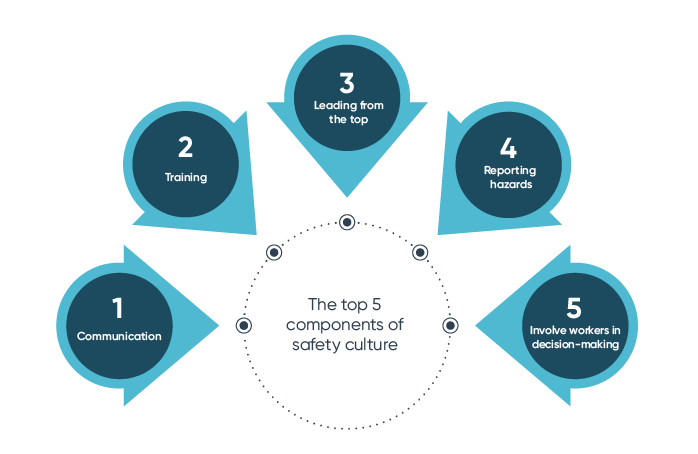What is safety culture and why your organization should be practicing it
Although ‘safety culture’ is a term that is often bandied around organizations, it is often simplified or misunderstood. In a nutshell, it refers to safety attitudes and behaviours within an organization. Or to be even more blunt, it’s simply ‘how things are done’. If an organization has a positive safety culture, this means that things are done safely.
In this blog post we take a look at the following questions:
- What does it mean to be safe at work?
- What is the relationship between safety culture and productivity?
- Where does the responsibility for safety lie in organizations?
- How do you implement a programme of health and safety training?
- Does safety include mental health?

How to assess safety culture in your organization
Before delving further into the topic of safety culture, take a moment of reflection and consider your responses to the following questions:
- Can workers, managers and senior leaders in your organization communicate their concerns to each other without fear of reproach?
- Do your employees known and understand safety procedures?
- Does the general population of your organization believe that safety is important?
- Can safety leaders and other managers collaborate on projects?
- Does the organization invest in PPE, equipment repairs and safety tech?
- Do leaders meet regularly to discuss opportunities for improving safety?
- Do leaders accept responsibility for organizational safety?
- Do workers feel empowered to address safety issues autonomously?
- Are there regular training opportunities to improve workers’ knowledge and understanding of safety?
If you answered ‘no’ to any of the above, you might need to address the safety culture in your organization and introduce some suggestions for optimizing workplace safety and wellbeing.
What is meant by a culture of safety?
According to the ACSNI Human Factors Study Group: Third Report (1993), the definition of a culture of safety is
'[...] the product of individual and group values, attitudes, perceptions, competencies, and patterns of behaviour that determine the commitment to, and the style and proficiency of, an organization’s health and safety management.'
While the organizational culture refers to the overall culture of the organization as a whole, safety culture is just one aspect of the organizational culture. For a safety culture to thrive, a strong and healthy organizational culture is needed: one that aligns with the company’s values and overall objectives.
Indeed, companies with a positive safety culture view safety as both a collective and an individual responsibility. Safety attitudes and behaviours are encouraged from the top to the bottom of an organization via the leadership and role modelling of supervisors, managers and the C-suite. Employees throughout the company also feel included in a safety dialogue via regular training sessions on the importance of health and safety.
Does safety culture hinder or bolster productivity?
At some point or another we’ve all had to attend a health and safety briefing or a dry training session with information overload. Unfortunately, safety is popularly viewed by many workers with cynicism: it is often considered to be a mandatory box-ticking exercise with little significance in their day-to-day jobs.
Moreover, in negative safety cultures, workers tend to ignore safety measures that they feel might hinder their productivity. In such cultures, the widespread consensus is often that deadlines and commercial interests should be put before safety measures.
While addressing health and safety issues in the workplace can be costly and time-consuming, there are many business benefits to be gleaned from a positive safety culture:
- Enhanced employee morale
- Increased employee productivity
- Minimal accidents/injuries
- Improved staff retention
- Stronger organizational reputation
In this respect, a positive safety culture is not only a legal requirement: it also helps businesses to enhance their productivity and improve their bottom lines.
The top 5 components of safety culture
1. Communication: Regular communications should be delivered across the organization to alert employees to safety messages. There should also be a safety board that is updated regularly.
2. Training: All employees should receive regular training on health and safety processes and policies. Steps should also be taken to monitor the effectiveness of the training. Any gaps or inconsistencies should be addressed through further training or one-to-ones.
3. Leading from the top: Leaders at all levels of the organization—team leaders, supervisors, managers and C-suite executives—take safety seriously and role model safe behaviours to other employees. This encourages buy-in from other employees because safety culture is ingrained in the company’s culture from the top.
4. Reporting hazards: The company encourages employees to feel comfortable about report hazards. A clear process for doing so is outlined to employees on the safety board and the staff intranet. Any reported hazards must be dealt with swiftly and efficiently. When hazards are dealt with appropriately, this strengthens the reporting culture of the organization.
5. Involve workers in decision-making: Employees’ buy-in to a safety culture increases when an organization gives them the chance to have input into decisions on workplace safety policies, training and processes.
Where to start with building a culture of safety
Remember that embedding a culture of safety starts from the top of an organization.
According to the UK’s HSE, it is the employer’s legal duty to manage the health and safety of workers in their organization. In this respect, it is not the responsibility of workers to take precautions to stay safe at work. Rather, the creation of a culture of safety must be led—legally—from the very top of an organization’s hierarchy.
According to the Management of Health and Safety at Work Regulations 1999, the minimum you must do is:
- Take measures to identify hazards
- Decide on the probability that someone could become harmed in the workplace and, if so, how serious the implications might be.
- Implement measures to eliminate the hazards or mitigate the risks.
However, beyond these minimum requirements, leaders at all levels of the organization play an important role in promoting a positive safety culture through regular health and safety training, internal campaigns and, crucially, in leading by example.
How to promote a positive safety culture
It doesn’t matter if they’re permanent staff, temporary recruits or contractors: all workers in an organisation need to understand how to do their job safely. When planning health and safety training, employers need to consider the specific needs of everyone in the organization. For example, when employees take on new responsibilities, their safety training needs might change.
Consider your training options. There’s no point in bombarding employees with time-consuming and highly detailed training sessions that have no relevance to their roles. Employee buy-in is likely to increase if the training is relevant, engaging and easy to understand.
The HSE states that all employees should be aware of and understand:
- emergency procedures
- hazards
- risks
- what actions have been taken by the business to control hazards and risks
Implement a system to determine the extent to which your workers found the training relevant and worthwhile. Digital training records can help you to monitor employees’ training attendance, allow you to send reminders and assess if additional training is necessary and worthwhile.
According to the HSE, health and safety training needs to be undertaken during working hours. It should also come at no cost to employees. While there are many outside organizations that can help you to implement health and safety training, it is possible to create effective training internally. As you know your workplace best and what the risks are, you can take steps to create nuanced, relevant and worthwhile training that is specifically tailored to employees’ needs.
Does safety culture include mental health?
Yes, absolutely! According to the law, it is an employer’s responsibility to assess the risk of work-related stress and ensure that proper measures are implemented to address any risks and protect workers.
Why is this important? Preventing stress brings valuable business benefits:
- It prevents ill health
- It reduces employee absence
- It enhances morale
- It bolsters productivity
The HSE advises that both employers and employees take proactive steps to recognise signs of stress in themselves and others. The key, they say, is to identify and treat stress in its early stages as this is when it can be more easily managed and controlled.
In the last decade we have witnessed the emergence of a collective mental health revolution. Led by initiatives such as the Time to Change social movement and the Duke of Cambridge’s Mental Health at Work Campaign, and a plethora of celebrities who have begun to tackle the subject on podcasts and social media, UK society has become generally much more conscious of mental health and the important foundation it plays in our individual and collective lives.
Indeed, while mental health was previously ignored, or swept under the carpet, by old-school managers of the past, employers of today are in a different playing field. Companies can no longer adopt ignore the dangerous consequences of stress in the workplace and must be accountable for creating environments which place staff wellbeing high on the list of organisational priorities.
Justin Basini, CEO of ClearScore, argues that it is important for leaders to be positive role models for creating a work-life balance: ‘[…] I think it’s really important to lead by example on this and demonstrate to my team how I am balancing my life.’
Indeed, mental health has increasingly come to be recognised by business leaders as a crucial aspect of organizational safety culture that is just as important (if not more!) than physical health. In order to create a positive health and safety culture, managers must promote a culture in which employees feel that they can be honest and open about mental health.
Promoting a positive safety culture to reduce stress at work
According to the HSE, these are the steps that line managers should follow when addressing stress in employees:
Working patterns
- Regular breaks should be encouraged, ‘especially when the work is complex or emotionally demanding’.
- Allow for changes to working patterns (e.g., start/end times) or flexible hours to enable workers to cope with additional pressures, such as childcare commitments, caring duties or commutes.
Workload
- Schedule regular catchups, both with individuals and as a team, to discuss workloads and anticipate any busy periods.
- Implement a system to alert employees of any unforeseen tight deadlines or requirements for working hours that are longer than usual.
- Encourage team leaders and supervisors to monitor the workloads of their teams and, crucially, to say no to additional work if their team is already at full capacity.
Environment
- Assess the risk of potential hazards. Then, take steps to address them by consulting with other employees. You can always look further afield to outside charities and organizations that can help. The HSE suggests that for the potential hazard of violence and aggression, you could seek advice from the police or specialist charities. ∙
- Try to reduce any unwanted distractions and consult with employees to develop systems for dealing with noise levels.
Support
- When conducting performance reviews/ appraisals, include work-related stress as an agenda item. You can also include this as a standing item for regular team meetings.
- Implement buddying systems and work shadowing to allow employees to gain a greater understanding of the different roles across the team. This is especially important for new starters.
Tackling shame: destigmatising mental health problems
- Run an internal comms campaign with the message that ‘it’s okay not to be okay’. Include a specific mental health page on the company’s intranet with relevant instructions and signposting on where to get help.
- Have an annual mental health week during which your organization focuses on wellness and self-care.
- Introduce training sessions that help employees to develop tools and strategies for coping with stress and on managing their time effectively.
What does the future hold?
Given the unprecedented impact that Covid-19 has had on health and safety culture, companies are also looking to technology to futureproof them from the threats of contagious viruses. Matt Blaydon, a building consultancy expert, explains that piloting is already in process on:
- Robot cleaners that spray disinfectant at a consistent rate and speed.
- AI to record disinfectant cycles, locations, and quality.
- AI to record who entered a building and where they went (to help track outbreaks).
- Heavier filtration systems to reduce the spread of airborne diseases.
- Touch-free technology throughout buildings. This can be implemented in hot drinks machines, doors, lights, security access points, lifts, toilets etc.
- Screening technology at entrances and exits that automatically check the temperature of visitors and employees.
- Toxicity level monitors throughout buildings.
Explore EHS solutions
Build better EHS processes, mitigate safety risks and protect employees with a unified solution for reporting incidents and managing safety.
Nicola spends her days thinking about how teams work better together —and how we can make document collaboration a little less painful with technology. She's particularly interested in helping teams within highly regulated industries, where data security and compliance are paramount, to streamline their processes and boost efficiency.


